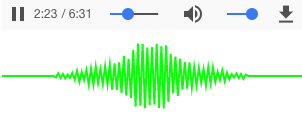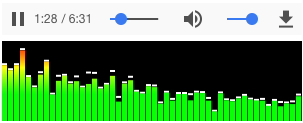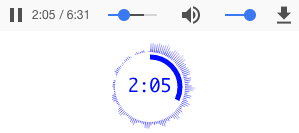Awesome
<p align="center"> <img src="https://github.com/staskobzar/vue-audio-visual/blob/master/static/logo.png?raw=true"/> </p>vue-audio-visual
Vue HTML5 audio visualization components
UPDATE NOTES
[!WARNING] Plugin current version is compatibale only with Vue v3. For Vue2 use plugin version 2.5.1. See install chapter for details.
Overview
An audio spectrum visualizer plugin for VueJS framework. It is built with HTML5 Web Audio API and compatible with all browsers that support HTML5 audio API. It provides several Vue components that allows to draw light and nice visualization for "audio" HTML elements.
[!NOTE] Visit DEMO page for working examples.
Usage examples:
Component AvLine. Vue template name <av-line>
<av-line :line-width="2" line-color="lime" src="/static/music.mp3"></av-line>
This will create following element:

Component AvBars. Vue template name <av-bars>
<av-bars
caps-color="#FFF"
:bar-color="['#f00', '#ff0', '#0f0']"
canv-fill-color="#000"
:caps-height="2"
src="/static/bach.mp3"
></av-bars>
This will create following element:

Component AvCircle. Vue template name <av-circle>
<av-circle
:outline-width="0"
:progress-width="5"
:outline-meter-space="5"
:playtime="true"
playtime-font="18px Monaco"
src="/static/bach.mp3"
></av-circle>
This will create following element:

Component AvWaveform. Vue template name <av-waveform>
<av-waveform src="/static/bar.mp3"></av-waveform>
This will create following waveform element:

Component will pre-load audio content and generate clickable waveform.
Component AvMedia. Vue component <AvMedia>
<AvMedia :media="mediaObject" type="vbar"></AvMedia>
This will create following media element:

There are more media types. See details below.
:gear: Get started
Install
Install using npm
npm install --save vue-audio-visual
for Vue 2 install version 2.5.1
npm i -S vue-audio-visual@2.5.1
Use plugin
Install plugin in main.js:
import { createApp } from "vue";
import App from "./App.vue";
import { AVPlugin } from "vue-audio-visual";
const app = createApp(App);
app.use(AVPlugin);
app.mount("#app");
Then anywhere is your app you can use it like this:
<av-bars src="/static/bach.mp3" bar-color="#CCC"> </av-bars>
Use component
Single component can be imported and used
<script setup lang="ts">
import { AVWaveform } from 'vue-audio-visual'
</script>
<template>
<AVWaveform src="http://foo.com/music.ogg" />
</template>
Composable functions
Plugin provides composable "use" functions for each plugin component. Actually, each component uses composable function inside. See, for example, line component.
Composable functions use audio and canvas element refs. It is handy when you need full access to audio or canvas elements. In the same time it is easy to use:
<script setup lang="ts">
import { ref } from 'vue'
import { useAVBars } from 'vue-audio-visual'
const player = ref(null)
const canvas = ref(null)
const mySource = "./symphony.mp3"
// composable function useAVBars
useAVBars(player, canvas, { src: mySource, canvHeight: 40, canvWidth: 200, barColor: 'lime' })
</script>
<template>
<div>
<audio ref="player" :src="mySource" controls />
<canvas ref="canvas" />
</div>
</template>
:gear: API
There are several components that comes with plugin. Here is the list of available plugins:
| Name | Component name | Composable function |
|---|---|---|
| av-bars | AVBars | useAVBars |
| av-circle | AvCircle | useAVCircle |
| av-line | AVLine | useAVLine |
| av-media | AVMedia | useAVMedia |
| av-waveform | AVWaveform | useAVWaveform |
There are props that are common for all components and special props for each component. All props for components' names follow vue specs when using wiht composable functions. Meaning when prop's name is "foo-bar" then in composable function parameter it is expected to be "fooBar".
Common props
<table> <thead> <tr> <th width="150">Name</th> <th>Type</th> <th>Default</th> <th>Description</th> </tr> </thead> <tbody> <tr> <td>src</td> <td><code>String</code></td> <td><code>null</code></td> <td> URL of Audio element src attribute. When provided creates audio element wrapped in "div". </td> </tr> <tr> <td>audio-controls</td> <td><code>Boolean</code></td> <td><code>true</code></td> <td> Audio element controls attribute. When provided should display audio element with controls. </td> </tr> <tr> <td>canv-fill-color</td> <td><code>String</code></td> <td><code>null</code></td> <td>Canvas fill background RGB color. Default is null, which makes background transperent. Examples:<br/> <code>canv-fill-color="#00AAFF"</code><br/> </td> </tr> </tbody> </table>AVLine props
<table> <thead> <tr> <th width="150">Name</th> <th>Type</th> <th>Default</th> <th>Description</th> </tr> </thead> <tbody> <tr> <td>canv-width</td> <td><code>Number</code></td> <td><code>300</code></td> <td>Canvas element width. Default 300. Example: <code>:canv-width="600"</code> </td> </tr> <tr> <td>canv-height</td> <td><code>Number</code></td> <td><code>80</code></td> <td>Canvas element height. Default 80. Example: <code>:canv-height="120"</code> </td> </tr> <tr> <td>line-width</td> <td><code>Number</code></td> <td><code>2</code></td> <td>Graph line width in px. Integer or float number. Example: <code>:line-width="0.5"</code> </td> </tr> <tr> <td>line-color</td> <td><code>String</code>, <code>Array</code></td> <td><code>#9F9</code></td> <td>Graph line color. Can be string RGB color or Array of RGB color. When Array is given, plugin creates linear gradient and set it as background. Array value should be binded. Examples:<br/> <code>line-color="#00AAFF"</code><br/> <code>:line-color="['#FFF', 'rgb(0,255,127)', '#00f']"</code> </td> </tr> <tr> <td>fft-size</td> <td><code>Number</code></td> <td><code>128</code></td> <td>Represents the window size in samples that is used when performing a Fast Fourier Transform (FFT) to get frequency domain data.<br/> Must be power of 2 between 2<sup>5</sup> and 2<sup>15</sup>. Example: <code>:fft-size="512"</code> </td> </tr> </tbody> </table>Composable function:
function useAVLine<T extends object>(
player: Ref<HTMLAudioElement | null>,
canvas: Ref<HTMLCanvasElement | null>,
props: T,
);
AVBars props
<table> <thead> <tr> <th width="150">Name</th> <th>Type</th> <th>Default</th> <th>Description</th> </tr> </thead> <tbody> <tr> <td>canv-width</td> <td><code>Number</code></td> <td><code>300</code></td> <td>Canvas element width. Default 300. Example: <code>:canv-width="600"</code> </td> </tr> <tr> <td>canv-height</td> <td><code>Number</code></td> <td><code>80</code></td> <td>Canvas element height. Default 80. Example: <code>:canv-height="120"</code> </td> </tr> <tr> <td>bar-width</td> <td><code>Number</code></td> <td><code>5</code></td> <td>Width of bars in pixels. Example: <code>:bar-width="12"</code> </td> </tr> <tr> <td>bar-space</td> <td><code>Number</code></td> <td><code>1</code></td> <td>Space between bars. Example: <code>:bar-space="1.6"</code></td> </tr> <tr> <td>bar-color</td> <td><code>String</code>, <code>Array</code></td> <td><code>#0A0AFF</code></td> <td>Bar fill color. Can be string RGB color or canvas gradients array.<br/> Examples:<br/> <code>bar-color="#00AAFF"</code><br/> <code>:bar-color="['#FFF', 'rgb(0,255,127)', 'green']"</code> </td> </tr> <tr> <td>caps-height</td> <td><code>Number</code></td> <td><code>0</code></td> <td>Create caps on bars with given height in pixels. When zero no caps created. Example: <code>:caps-height="2"</code> </td> </tr> <tr> <td>caps-drop-speed</td> <td><code>Number</code></td> <td><code>0.9</code></td> <td>Caps drop down animation speed. The higher nubmer the faster caps are going down. Example: <code>:caps-drop-speed="0.5"</code> </td> </tr> <tr> <td>caps-color</td> <td><code>String</code></td> <td><code>#A0A0FF</code></td> <td>Caps rectangles RGB color. Example: <code>caps-color="lime"</code> </td> </tr> <tr> <td>brick-height</td> <td><code>Number</code></td> <td><code>0</code></td> <td>Draw bar as bricks when height is set and not zero.<br/> Example: <code>:brick-height="6"</code><br/> <img src="https://github.com/staskobzar/vue-audio-visual/blob/master/static/vav-bars-bricks.png?raw=true" /> </td> </tr> <tr> <td>brick-space</td> <td><code>Number</code></td> <td><code>1</code></td> <td>Space between bricks. Example: <code>:brick-space="2"</code> </td> </tr> <tr> <td>symmetric</td> <td><code>Boolean</code></td> <td><code>false</code></td> <td>Draw bars symmetric to canvas vertical center. Example: <code>:symmetric="true"</code><br/> <img src="https://github.com/staskobzar/vue-audio-visual/blob/master/static/vav-bars-symm.png?raw=true" /> </td> </tr> <tr> <td>fft-size</td> <td><code>Number</code></td> <td><code>1024</code></td> <td>Represents the window size in samples that is used when performing a Fast Fourier Transform (FFT) to get frequency domain data.<br/> Must be power of 2 between 2<sup>5</sup> and 2<sup>15</sup>. Example: <code>:fft-size="2048"</code> </td> </tr> </tbody> </table>Composable function
function useAVBars<T extends object>(
player: Ref<HTMLAudioElement | null>,
canvas: Ref<HTMLCanvasElement | null>,
props: T,
);
AVCircle props
<table> <thead> <tr> <th width="150">Name</th> <th>Type</th> <th>Default</th> <th>Description</th> </tr> </thead> <tbody> <tr> <td>canv-width</td> <td><code>Number</code></td> <td><code>100</code></td> <td>Canvas element width. Example: <code>:canv-width="600"</code> </td> </tr> <tr> <td>canv-height</td> <td><code>Number</code></td> <td><code>100</code></td> <td>Canvas element height. Example: <code>:canv-height="120"</code> </td> </tr> <tr> <td>radius</td> <td><code>Number</code></td> <td><code>0</code></td> <td>Base circle radius. If zero, then will be calculated from canvas width: (canv-width / 2) * 0.7 Example: <code>:radius="20"</code> </td> </tr> <tr> <td>line-width</td> <td><code>Number</code></td> <td><code>1</code></td> <td>Frequency bit line width to draw. Example: <code>:line-width="0.4"</code> </td> </tr> <tr> <td>line-space</td> <td><code>Number</code></td> <td><code>1</code></td> <td>Space between lines to draw. Example: <code>:line-space="2"</code> </td> </tr> <tr> <td>outline-color</td> <td><code>String</code></td> <td><code>#0000FF</code></td> <td>Outline (contour) style RGB color. Example: <code>outline-color="rgb(0,255,0)"</code> </td> </tr> <tr> <td>outline-width</td> <td><code>Number</code></td> <td><code>0.3</code></td> <td>Outline (contour) line width. Float value. Example: <code>:outline-width="1"</code> </td> </tr> <tr> <td>bar-width</td> <td><code>Number</code></td> <td><code>1</code></td> <td>Frequency graph bar width. Example: <code>:bar-width="1"</code> </td> </tr> <tr> <td>bar-length</td> <td><code>Number</code></td> <td><code>0</code></td> <td>Frequency graph bar length/height. Default is a difference between radius and canvas width. Example: <code>:bar-length="27"</code> </td> </tr> <tr> <td>bar-color</td> <td><code>String</code>, <code>Array</code></td> <td><code>[#FFF,#00F]</code></td> <td>Bar style RGB color or radient gradient when array. Example: <code>:bar-color="#12AA55"</code> </td> </tr> <tr> <td>progress</td> <td><code>Boolean</code></td> <td><code>true</code></td> <td>Draw playtime progress meter. Example: <code>:progress="false"</code> </td> </tr> <tr> <td>progress-width</td> <td><code>Number</code></td> <td><code>1</code></td> <td>Playtime progress meter width. Example: <code>:progress-width="2.4"</code> </td> </tr> <tr> <td>progress-color</td> <td><code>String</code></td> <td><code>#0000FF</code></td> <td>Playtime progress meter color. Example: <code>:progress-color="green"</code> </td> </tr> <tr> <td>progress-clockwise</td> <td><code>Boolean</code></td> <td><code>false</code></td> <td>Playtime progress meter arc draw direction. Example: <code>:progress-clockwise="true"</code> </td> </tr> <tr> <td>outline-meter-space</td> <td><code>Number</code></td> <td><code>3</code></td> <td>Space between outline and progress meter. The bigger the closer to the circle centre. Example: <code>:outline-meter-space="1"</code> </td> </tr> <tr> <td>playtime</td> <td><code>Boolean</code></td> <td><code>false</code></td> <td>Draw played time as text in the center of the circle. Example: <code>:playtime="true"</code> </td> </tr> <tr> <td>playtime-font</td> <td><code>String</code></td> <td><code>14px Monaco</code></td> <td>Played time print font. Example: <code>playtime-font="18px monospace"</code> </td> </tr> <tr> <td>playtime-color</td> <td><code>String</code></td> <td><code>#00f</code></td> <td>Played time font color. Example: <code>playtime-color="green"</code> </td> </tr> <tr> <td>rotate-graph</td> <td><code>Boolean</code></td> <td><code>false</code></td> <td>Rotate graph clockwise enable. Example: <code>:rotate-graph="true"</code> </td> </tr> <tr> <td>rotate-speed</td> <td><code>Number</code></td> <td><code>0.001</code></td> <td>Rotate graph speed. Example: <code>:rotate-speed="0.2"</code> </td> </tr> <tr> <td>fft-size</td> <td><code>Number</code></td> <td><code>1024</code></td> <td>Represents the window size in samples that is used when performing a Fast Fourier Transform (FFT) to get frequency domain data.<br/> Must be power of 2 between 2<sup>5</sup> and 2<sup>15</sup>. Example: <code>:fft-size="2048"</code> </td> </tr> </tbody> </table>Composable function
function useAVCircle<T extends object>(
player: Ref<HTMLAudioElement | null>,
canvas: Ref<HTMLCanvasElement | null>,
props: T,
);
AVWaveform props
<table> <thead> <tr> <th width="150">Name</th> <th>Type</th> <th>Default</th> <th>Description</th> </tr> </thead> <tbody> <tr> <td>canv-width</td> <td><code>Number</code></td> <td><code>500</code></td> <td>Canvas element width. Example: <code>:canv-width="600"</code> </td> </tr> <tr> <td>canv-height</td> <td><code>Number</code></td> <td><code>80</code></td> <td>Canvas element height. Example: <code>:canv-height="120"</code> </td> </tr> <tr> <td>played-line-width</td> <td><code>Number</code></td> <td><code>0.5</code></td> <td>Waveform line width for played segment of audio. Example: <code>:playtime-line-width="0.8"</code> </td> </tr> <tr> <td>played-line-color</td> <td><code>String</code></td> <td><code>navy</code></td> <td>Waveform line color for played segment of audio. Example: <code>:playtime-line-color="#ABC123"</code> </td> </tr> <tr> <td>noplayed-line-width</td> <td><code>Number</code></td> <td><code>0.5</code></td> <td>Waveform line width for not yet played segment of audio Example: <code>:noplayed-line-width="1"</code> </td> </tr> <tr> <td>noplayed-line-color</td> <td><code>String</code></td> <td><code>lime</code></td> <td>Waveform line color for not yet played segment of audio. Example: <code>:noplayed-line-color="grey"</code> </td> </tr> <tr> <td>playtime</td> <td><code>Boolean</code></td> <td><code>true</code></td> <td>Display played time next to progress slider. Example: <code>:playtime="false"</code> </td> </tr> <tr> <td>playtime-with-ms</td> <td><code>Boolean</code></td> <td><code>true</code></td> <td>Display milliseconds in played when true. For example: 02:55.054. Example: <code>:playtime-with-ms="false"</code> </td> </tr> <tr> <td>playtime-font-size</td> <td><code>Number</code></td> <td><code>12</code></td> <td>Played time print font size in pixels. Example: <code>:playtime-font-size="14"</code> </td> </tr> <tr> <td>playtime-font-family</td> <td><code>String</code></td> <td><code>monospace</code></td> <td>Played time print font family. Example: <code>:playtime-font-family="monaco"</code> </td> </tr> <tr> <td>playtime-font-color</td> <td><code>String</code></td> <td><code>grey</code></td> <td>Played time print font RGB color string. Example: <code>:playtime-font-color="#00f"</code> </td> </tr> <tr> <td>playtime-text-bottom</td> <td><code>Boolean</code></td> <td><code>false</code></td> <td>Position playtime text bottom. Default on top. Example: <code>playtime-text-bottom</code> </td> </tr> <tr> <td>playtime-slider</td> <td><code>Boolean</code></td> <td><code>true</code></td> <td>Draw played time slider on the waveform. Example: <code>:playtime-slider="false"</code> </td> </tr> <tr> <td>playtime-slider-color</td> <td><code>String</code></td> <td><code>red</code></td> <td>Played slider color. Example: <code>:playtime-slider-color="#fafafa"</code> </td> </tr> <tr> <td>playtime-slider-width</td> <td><code>Number</code></td> <td><code>1</code></td> <td>Played slider width. Example: <code>:playtime-slider-width="2.5"</code> </td> </tr> <tr> <td>playtime-clickable</td> <td><code>Boolean</code></td> <td><code>true</code></td> <td>Allow click on waveform to change playtime. Example: <code>:playtime-clickable="false"</code> </td> </tr> </tbody> </table>Composable function is using useFetch from
@vueuse/core package. useAVWaveform last argument is
options for "createFetch" function from "useFetch" module.
export function useAVWaveform<T extends object>(
player: Ref<HTMLAudioElement | null>,
canvas: Ref<HTMLCanvasElement | null>,
props: T,
fetchOpts: CreateFetchOptions = {},
);
AVMedia props
Component expects MediaStream object. You can get it directly from
navigator.mediaDevices or from @vueuse/core library function
useUserMedia. Live example can be found
in
App.vue.
<script setup lang="ts">
import { AVMedia } from 'vue-audio-visual'
import { useUserMedia } from '@vueuse/core'
...
const { stream } = useUserMedia()
...
</script>
<template>
...
<AVMedia :media="stream" type="circle" />
...
</template>
Composable function:
function useAVMedia<T extends object>(
canvas: Ref<HTMLCanvasElement | null>,
props: T,
);
License
MIT Copyright (c) 2018-present, Stas Kobzar

